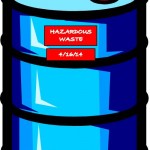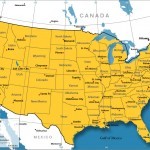Both Large Quantity Generators and Small Quantity Generators of hazardous waste are responsible for the cradle-to-grave management of the hazardous waste they generate. One of their responsibilities is to properly identify containers of hazardous waste when it is accumulated on-site and when it is offered for off-site transportation. As an LQG or SQG it is important for you to know the distinct requirements for identifying your hazardous waste both when it is at its accumulation or storage area, and when it is being prepared for off-site transportation.
Not sure of your hazardous waste generator status? |
During the time that a hazardous waste container is being used to accumulate or store hazardous waste prior to off-site transportation (≤90 days for an LQG and ≤180 days for an SQG) it is subject to the regulations of 40 CFR 262.34(a)(2) & (3) which requires the following information to be clearly visible on the hazardous waste container:
- The date of hazardous waste accumulation, that is: the date hazardous waste was first placed in the container. THE FIRST DROP!
- The words “Hazardous Waste”.
And…that’s it. Nothing else is required per the USEPA regulations. Your state may be a different matter, so please check with them to determine if they require any additional identification on the hazardous waste container.

Note that this labeling/marking requirement is different from what is required for a hazardous waste container in a Satellite Accumulation Area pursuant to 40 CFR 262.34(c):
- Mark the container with the words “Hazardous Waste” or with other words that identify the contents of the container; eg. “Used Solvent”.
Naturally the date of hazardous waste accumulation is not required on a container in an SAA since their is no on-site accumulation time limit for hazardous waste in an SAA. Check with your state though, since at least two I am aware of (Missouri & California) have a one year time limit in an SAA.
The date of accumulation and “Hazardous Waste” is sufficient while the container is accumulated on-site, but what about its off-site transportation? While USEPA enforces cradle-to-grave responsibility for a hazardous waste, the primary regulatory agency for the transportation in commerce of a hazardous waste is the USDOT. Therefore, while largely referencing the USDOT regulations for compliance, the USEPA has some unique requirements of its own.
40 CFR 262.30 Packaging:
The hazardous waste accumulation container must be packaged according to the applicable USDOT regulations for packaging:
- 49 CFR 173 – Shippers – General Requirements for Shipments and Packaging
- 49 CFR 178 – Specifications for Packagings
- 49 CFR 179 – Specifications for Tank Cars
Note: Under USEPA regulations it is referred to as a “container” whereas under USDOT regulations it is referred to as a “packaging” before filling and a “package” when filled and closed. Read more about the USDOT regulations for packagings and packages.
40 CFR 262.31 Labeling:
Once “packaged” according to USDOT regulations, the generator must now affix an applicable HazMat Label to each package for at least one primary hazard, and possibly more for subsidiary hazards, pursuant to 49 CFR 172, Subpart E.
Like this article? Subscribe to my Monthly Newsletter No marketing emails! |
40 CFR 262.32 Marking
It is under the requirement for marking the hazardous waste packaging where USEPA regulations can get confusing. They start easy enough in sub-paragraph (a) which requires each package to be marked in accordance with USDOT regulations at 49 CFR 172, Subpart D. At a minimum this will include:
- Proper shipping name, preceded by the word “waste” unless “waste” already appears in the proper shipping name.
- Four digit identification number preceded by either a “UN” or “NA”.
In sub-paragraph (b) USEPA requires a specific marking but only for containers of 119 gallons or less.
- “HAZARDOUS WASTE – Federal Law Prohibits Improper Disposal. If found, contact the nearest police or public safety authority or the U.S. Environmental Protection Agency.”
- Generator’s Name and Address (street address, not mailing).
- Generator’s EPA Identification Number (don’t use your state identification number, if you have one, by mistake).
- Manifest Tracking Number (from the upper right corner of the Uniform Hazardous Waste Manifest).
The confusion stems from the limitation of this requirement to solely containers of 119 gallons or less. Though not referenced directly, I assume this threshold is based on the definition of a non-bulk packaging found in the USDOT regulations at 49 CFR 171.8:
Non-bulk packaging means a packaging which has:
(1) A maximum capacity of 450 L (119 gallons) or less as a receptacle for a liquid;
(2) A maximum net mass of 400 kg (882 pounds) or less and a maximum capacity of 450 L (119 gallons) or less as a receptacle for a solid; or
(3) A water capacity of 454 kg (1000 pounds) or less as a receptacle for a gas as defined in §173.115 of this subchapter.
So, compliance with 40 CFR 262.32 requires the following:
- All containers/packages of hazardous waste (bulk and non-bulk) must be marked per the regulations of the USDOT (49 CFR 172, Subpart D).
- All non-bulk (≤119 gal) containers/packages of hazardous waste must also be marked with the information specified at 40 CFR 262.32(b).
- Bulk (>119 gal) containers/packages of hazardous waste may be marked with the information specified at 40 CFR 262.32(b) but are not required to be so.
Daniels Training Services 815.821.1550/Info@DanielsTraining.com/https://danielstraining.com/ |
Question: If I accumulate hazardous waste in an intermediate bulk packaging (IBC) with a capacity of approximately 350 gallons, am I required to mark the packaging with the information specified at 40 CFR 262.32(b) prior to offering it for off-site transportation?
Answer: No. The requirements of 40 CFR 262.32(b) do not apply to containers/packagings of >119 gallons (ie. bulk packagings).
Some points to consider about the above regulations:
- Responsibility for compliance is solely that of the generator of the hazardous waste. Though a transporter or consultant may assist you with this process and even perform these functions for you, you cannot escape your responsibility as the generator codified in these regulations.
- These regulations are effective as soon as the containers are prepared for off-site transportation, typically this is when the transporter is on-site and the hazardous waste’s off-site transportation is imminent.
- Whenever the content for a marking or labeling is specified by the USEPA – eg. 40 CFR 262.34(a)(2) & (3) and §262.32(b) – no specification is made for the form of the label or marking itself. In other words, you could write the words “Hazardous Waste” on a hazardous waste container as long as it was clear and visible. The same cannot be said where a reference is made to USDOT regulations for markings and labels. The USDOT does have very specific requirements for the shape, color, and size of its hazard communication methods.
Question: May I make my own markings and labels for my hazardous waste containers that meet the requirements of the USEPA and the USDOT for both on-site accumulation and off-site transportation?
Answer: Yes you may, though compliance with the USDOT marking and labeling regulations will be more difficult since it has specifications for the size, color, contrast, etc. of labels and markings codified in its regulations. The USEPA does not have such specifications, however. Compliance with USEPA marking and labeling regulations can be accomplished with a good marker or some paint.
As always, check with your state to confirm compliance with these Federal regulations.

As a LQG or SQG you must train all facility personnel whose job responsibilities have anything to do with the generation, on-site handling, off-site transportation, or disposal of hazardous waste. Additionally, the regulations of the USDOT require training for anyone involved in the transportation of hazardous materials (which includes hazardous waste). Contact me for a free consultation on your training requirements.

